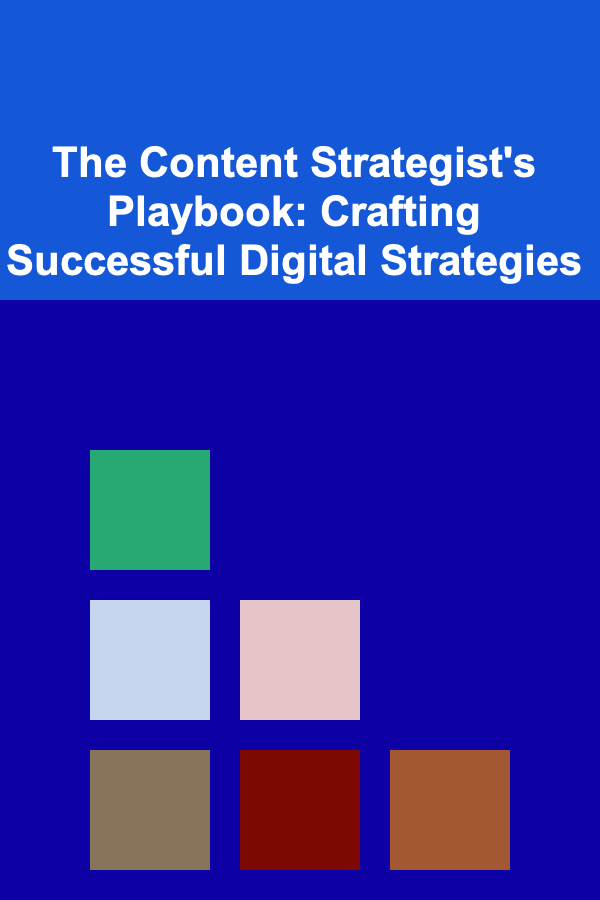
The Content Strategist's Playbook: Crafting Successful Digital Strategies
ebook include PDF & Audio bundle (Micro Guide)
$12.99$6.99
Limited Time Offer! Order within the next:

In the digital age, content is not just king---it's the very foundation of how businesses communicate, engage, and drive success online. Crafting a successful digital strategy is an art, one that combines creativity, data, and a deep understanding of audience behavior. For content strategists, the task is to ensure that content aligns with the business's objectives, resonates with the target audience, and ultimately contributes to growth and success.
In this actionable guide, we'll break down the essential steps and best practices for building and executing a digital content strategy that can propel a brand to new heights.
Understand the Business Goals
A successful digital content strategy begins with a clear understanding of the organization's broader business goals. This is the foundation upon which every piece of content will rest. Without aligning content with the larger business strategy, even the most creative or well-crafted content can fall flat.
Key Actions:
- Identify business objectives: Whether it's driving sales, increasing brand awareness, or enhancing customer loyalty, understand the specific goals your content needs to support.
- Collaborate with stakeholders: Regularly communicate with marketing teams, sales teams, product developers, and leadership to ensure alignment between content and business goals.
- Establish KPIs: Set measurable key performance indicators (KPIs) that reflect both the business goals and the effectiveness of the content. For instance, sales revenue, website traffic, social media engagement, or conversion rates.
Know Your Audience
Content can only be successful if it speaks to the right people in a way that resonates with their needs, desires, and challenges. Understanding your audience is crucial to crafting a strategy that not only grabs attention but also nurtures long-term engagement.
Key Actions:
- Conduct audience research: Use tools like Google Analytics, social media insights, and surveys to gather demographic and psychographic data. Dive into customer personas---detailed profiles of your target customers that include information about their age, interests, problems, and buying behaviors.
- Map out the customer journey: Understand the stages your audience goes through, from awareness to consideration to decision-making. Tailor your content strategy to meet the needs of your audience at each stage.
- Analyze competitors: Identify how competitors are positioning themselves in the digital space. Look for gaps in their content strategy that you can capitalize on, or take note of their strengths to inspire your own approach.
Develop a Content Plan
Once you've aligned content with business goals and understood your audience, it's time to develop a content plan. A well-structured content plan ensures that you create, distribute, and promote content consistently and effectively.
Key Actions:
- Define content types: Different types of content serve different purposes. Whether it's blog posts, social media updates, video content, infographics, or case studies, determine which formats will resonate most with your audience. Diversify content types to engage users in various ways.
- Create a content calendar: Plan content in advance, scheduling out topics, themes, and publication dates. A content calendar helps ensure consistency, prevents content gaps, and aligns with key dates such as product launches or seasonal campaigns.
- Plan for content repurposing: One of the most efficient ways to maximize content value is by repurposing it across different channels. For example, a well-performing blog post can be turned into an infographic, podcast episode, or social media posts.
- Establish content pillars: Identify key topics (pillars) that align with both your audience's interests and your business goals. These pillars will help ensure that your content remains consistent and relevant over time.
Create High-Quality, Valuable Content
Now comes the heart of the strategy: content creation. The quality of the content you produce will directly impact its ability to engage your audience and achieve your goals. The digital world is crowded, so standing out with meaningful, well-crafted content is essential.
Key Actions:
- Focus on value: Each piece of content should provide real value to your audience. Whether it's solving a problem, answering a question, or offering unique insights, the content must be relevant and actionable.
- Optimize for search: SEO (Search Engine Optimization) plays a crucial role in content success. Research keywords, implement on-page SEO best practices (like including keywords in headlines, meta descriptions, and alt text), and focus on creating long-form, authoritative content that ranks well in search engines.
- Use storytelling: People are naturally drawn to stories. Integrate storytelling into your content to make it more relatable and emotionally engaging. Whether you're sharing a customer success story or narrating the brand's journey, storytelling is a powerful tool in content marketing.
- Maintain a consistent tone and voice: Your content should reflect the personality and values of your brand. Whether your tone is professional, friendly, or humorous, it should remain consistent across all content types to build a cohesive brand identity.
Leverage Multiple Channels for Distribution
Content doesn't exist in a vacuum. To reach the right people, your content needs to be distributed across the appropriate channels, both owned and earned.
Key Actions:
- Optimize for each platform: Not all content works the same way across every platform. Tailor your content for each channel (e.g., Instagram, LinkedIn, YouTube, email newsletters) by considering the unique preferences and behaviors of users on those platforms.
- Use social media strategically: Social media is a great way to amplify your content. Share and promote blog posts, videos, and infographics. Use paid social campaigns to reach a broader audience. Interact with your audience by responding to comments, sharing user-generated content, and participating in conversations.
- Leverage partnerships and influencers: Collaborate with influencers, bloggers, or partners within your industry to expand your reach and gain credibility.
- Email marketing: Use email to nurture leads and engage your existing audience. A strong email marketing strategy can help convert prospects into customers by delivering personalized, relevant content directly to their inbox.
Monitor, Measure, and Optimize
Once your strategy is in motion, the work doesn't stop. A successful content strategy requires ongoing monitoring, analysis, and optimization. This allows you to make data-driven decisions and continually improve content performance.
Key Actions:
- Track KPIs and performance metrics: Use analytics tools (Google Analytics, social media insights, etc.) to measure how well your content is performing against your KPIs. Analyze page views, bounce rates, engagement rates, conversion rates, etc.
- A/B test content: Regularly conduct A/B tests to experiment with different headlines, images, calls to action, and formats. This helps you understand what resonates best with your audience and continually fine-tune your strategy.
- Gather qualitative feedback: Beyond quantitative metrics, gather feedback from your audience to understand their thoughts on the content. Encourage reviews, conduct surveys, or ask for input through social media.
- Refine the content plan: Based on performance data, adjust your content calendar, create more of the types of content that perform well, and ditch or rework the ones that aren't achieving the desired results.
Stay Agile and Adapt to Change
Digital marketing and consumer behavior evolve rapidly. A rigid content strategy can quickly become outdated. Content strategists must remain flexible and ready to pivot as needed.
Key Actions:
- Stay updated on trends: Follow industry blogs, attend webinars, and participate in conferences to stay on top of the latest content marketing trends and tools.
- Adapt to algorithm changes: Social media platforms and search engines frequently update their algorithms. Stay informed about these changes and adjust your content strategy accordingly to ensure visibility.
- Be responsive to audience feedback: If your audience is asking for something specific or expressing dissatisfaction, be ready to adapt your content accordingly.
Conclusion
Crafting a successful digital content strategy is a dynamic and ongoing process. It's about understanding the business, aligning content with customer needs, and continuously optimizing based on data and feedback. As a content strategist, your job is not just to create content but to ensure it is purposeful, relevant, and impactful.
By following the steps outlined in this playbook---understanding your goals, researching your audience, creating high-quality content, distributing it effectively, and continuously optimizing---you can build a content strategy that drives real business outcomes and positions your brand as a leader in the digital space.

How to Create a Functional Mudroom with Smart Storage Solutions
Read More
How to Incorporate Traditional Holiday Colors into Your Home Decor
Read More
How to Install Dimmable Lighting for More Control
Read More
How to Maximize Bathroom Storage with Over-the-Door Solutions
Read More
How to Teach Editing Techniques for YouTube and Social Media Content
Read More
How to Use Pegboards for Creative Storage Solutions
Read MoreOther Products

How to Create a Functional Mudroom with Smart Storage Solutions
Read More
How to Incorporate Traditional Holiday Colors into Your Home Decor
Read More
How to Install Dimmable Lighting for More Control
Read More
How to Maximize Bathroom Storage with Over-the-Door Solutions
Read More
How to Teach Editing Techniques for YouTube and Social Media Content
Read More